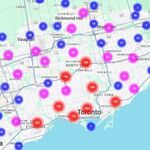Juan_Lennon416
Senior Member
You should also worry about the City of Toronto or urban planners in the private sector bringing up ideas such as burying streetcar lines within the downtown core
I would worry more about the City of Toronto or urban planners in the private sector bringing up ideas such as burying streetcar lines within the downtown core
Unfortunately, FRED doesn't run anymore. Your point stands though. I've been noting many cities not only have free transit in the core, they subsidize it because it pays for itself many times over.Many other cities have something similar. Halifax has FRED - Free rides Everywhere Downtown.
Doug Ford wrote (allegedly) an editorial in the Sunday Sun, at this link, on the
FORD: John Tory's King Street pilot project a disaster
This plan relies way too critically on enforcement. That's a major problem in this city. Are we going to have cops permanently stationed at every intersection?
Good thing this is a pilot. They're going to discover pretty quickly that many drivers will not be following the new rules whether maliciously or through confusion.
The St Clair corridor wasn't a pilot project. Melbourne's trams are not a pilot project. The point of a pilot project is in order to evaluate how effective the project is, before we spend more money to implement it on a more permanent basis. If we introduce new variables such as a 2 hour transfer, it makes it more difficult to measure if ridership increased because of the project or because of a 2 hour transfer.Claims re "How are 'they' supposed to know how effective the Corridor is without tapping?" are superfluous. It didn't stop the TTC tabulating rides on the St Clair route, or Melbourne on their many routes that traverse the free zone.
Back to the pilot, I can confirm that compliance has really taken a nosedive. I was at Portland Variety (it was busy there by the way) having an hour long meeting and I kept a rough count looking out the window. Out of about 70 cars that approached the intersection on King at Portland, 50 of them went straight through or made an illegal left turn. Out of the 20 that turned, I wonder how many would have turned anyway. This is a complete mess. Over 70% of drivers completely ignored the road markings and signs.
I hate to say “I told you so” but I told you so.
Back in May, when the model was revealed, I said:

Hey, maybe merchants and shoppers as well as riders and critics count as well? How's that exact count going on motorists obeying signs and signals or not? How about bunching up? How about waiting times at stops?The point of a pilot project is in order to evaluate how effective the project is, before we spend more money to implement it on a more permanent basis. If we introduce new variables such as a 2 hour transfer, it makes it more difficult to measure if ridership increased because of the project or because of a 2 hour transfer.
Indeed. A cursory Google search shows a litany of cities, many in North Am, most of those in the US of all places, that have free fare zones, almost all in the city core. https://en.wikipedia.org/wiki/Free_public_transport#AmericasSalt Lake City has a free zone too. C'mon Toronto. Make DMW or Mammo's head explode.
http://www.mto.gov.on.ca/english/transit/supportive-guideline/ridership-strategies.shtmle]Screenshot from 2017-12-31

this
Strategies:
affordability
- Make fares more affordable by providing reduced base fares, free transfers, free fare zones or discounts for multi-ride tickets and passes.
- Transfers can be simplified by offering short-term (e.g. 90-minute) unlimited, not directionally restricted, ride passes to encourage transit use for quick errands. A day pass that is priced at the equivalent of two or three linked trips can also help to improve rider convenience, minimize fare administration and minimize rider-operator arguments regarding transfer validity.
etc....
Maybe the simplest thing to do is to make TTC free on King from Bathurst to Jarvis. This costs nothing to implement and would just require fare inspectors not to check fares in that area. People could pay a fare to use the rest of the system. It would be a great PR campaign to support business.
I'm not very interested in using money from TTC's precious operating budget to support these businesses with their overhyped problems. We saw the exact same exaggerated problems with the Bloor Street bike lanes.
I'm not very interested in using money from TTC's precious operating budget to support these businesses with their overhyped problems. We saw the exact same exaggerated problems with the Bloor Street bike lanes.
Not all of them have "overhyped problems."
I was on King today for the first time since the pilot started. The empty streeet was eerie but cool. There were a lot of pedestrians despite the cold. The few cars I saw mostly ignored the signs and didn’t turn off King where indicated. The streetcar moved along nicely.




